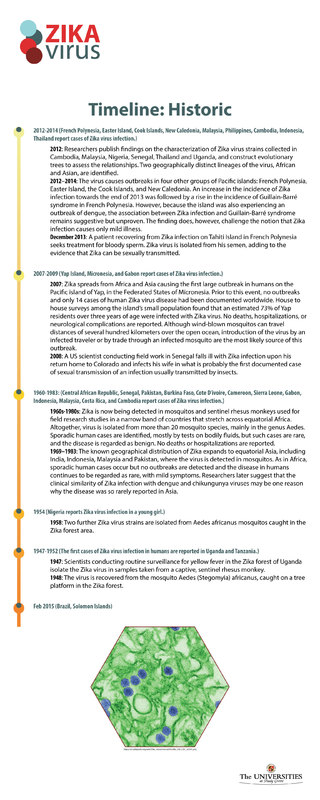Zika Timeline: Historic
2012-2014 (French Polynesia, Easter Island, Cook Islands, New Caledonia, Malaysia, Philippines, Cambodia, Indonesia, Thailand report cases of Zika virus infection.)
2012: Researchers publish findings on the characterization of Zika virus strains collected in Cambodia,Malaysia,Nigeria,Senegal,Thailand and Uganda, and construct evolutionary trees to assess the relationships. Two geographically distinct lineages of the virus, African and Asian, are identified.
2012–2014: The virus causes outbreaks in four other groups of Pacific Islands: French Polynesia, Easter Island, the Cook Islands, and New Caledonia. An increase in the incidence of Zika infection towards the end of 2013 was followed by a rise in the incidence of Guillain-Barré syndrome in French Polynesia. However, because the island was also experiencing an outbreak of dengue,the association between Zika infection and Guillain-Barré syndrome remains suggestive but unproven. The finding does, however, challenge the notion that Zika infection causes only mild illness.
December 2013: A patient recovering from Zika infection on Tahiti Island in French Polynesia seeks treatment for bloody sperm. Zika virus is isolated from his semen, adding to the evidence that Zika can be sexually transmitted.
2007-2009 (Yap Island, Micronesia, and Gabon report cases of Zika virus infection.)
2007: Zika spreads from Africa and Asia causing the first large outbreak in humans on the Pacific Island of Yap, in the Federated States of Micronesia. Prior to this event, no outbreaks and only 14 cases of human Zika virus disease had been documented worldwide.House to house surveys among the island’s small population found that an estimated 73% of Yap residents over three years of age were infected with Zika virus. No deaths, hospitalizations, or neurological complications are reported. Although wind-blown mosquitos can travel distances of several hundred kilometers over the open ocean, introduction of the virus by an infected traveler or by trade through an infected mosquito are the most likely source of this outbreak.
2008: A US scientist conducting field work in Senegal falls ill with Zika infection upon his
return home to Colorado and infects his wife in what is probably the first documented case
of sexual transmission of an infection usually transmitted by insects.
1960-1983: (Central African Republic, Senegal, Pakistan, Burkina Faso, Cote D'ivoire, Cameroon, Sierra Leone, Gabon, Indonesia, Malaysia, Costa Rica, and Cambodia report cases of Zika virus infection.)
1960s-1980s: Zika is now being detected in mosquitos and sentinel rhesus monkeys used for
field research studies in a narrow band of countries that stretch across equatorial Africa.
Altogether, virus is isolated from more than 20 mosquito species, mainly in the genus Aedes.
Sporadic human cases are identified, mostly by tests on bodily fluids, but such cases are rare,
and the disease is regarded as benign. No deaths or hospitalizations are reported.
1969–1983: The known geographical distribution of Zika expands to equatorial Asia, including
India, Indonesia, Malaysia and Pakistan, where the virus is detected in mosquitos. As in Africa,
sporadic human cases occur but no outbreaks are detected and the disease in humans
continues to be regarded as rare, with mild symptoms. Researchers later suggest that the
clinical similarity of Zika infection with dengue and chikungunya viruses may be one reason
why the disease was so rarely reported in Asia.
1954 (Nigeria reports Zika virus infection in a young girl.)
1958: Two further Zika virus strains are isolated from Aedes africanus mosquitos caught in the
Zika forest area.
1947-1952 (The first cases of Zika virus infection in humans are reported in Uganda and Tanzania.)
1947: Scientists conducting routine surveillance for yellow fever in the Zika forest of Uganda
isolate the Zika virus in samples taken from a captive, sentinel rhesus monkey.
1948: The virus is recovered from the mosquito Aedes (Stegomyia) africanus, caught on a tree platform in the Zika forest.
Feb 2015 (Brazil, Solomon Islands)
